The 30 Best Places to Live in North Carolina: A Complete Guide

North Carolina offers diverse landscapes and communities that appeal to residents seeking different lifestyles and priorities.
From the mountain towns in the western regions to coastal cities along the Atlantic, the state provides options for those drawn to urban centers, suburban neighborhoods, and smaller communities.
This comprehensive guide examines thirty cities and towns across North Carolina, evaluating factors like cost of living, employment opportunities, educational resources, and quality of life to help potential residents make informed decisions.
The analysis covers major metropolitan areas like Charlotte and Raleigh alongside smaller communities such as Boone and Hendersonville, providing insights into what makes each location distinctive for different types of residents.
Here are the 30 best places to live in North Carolina:
30. Hoffman
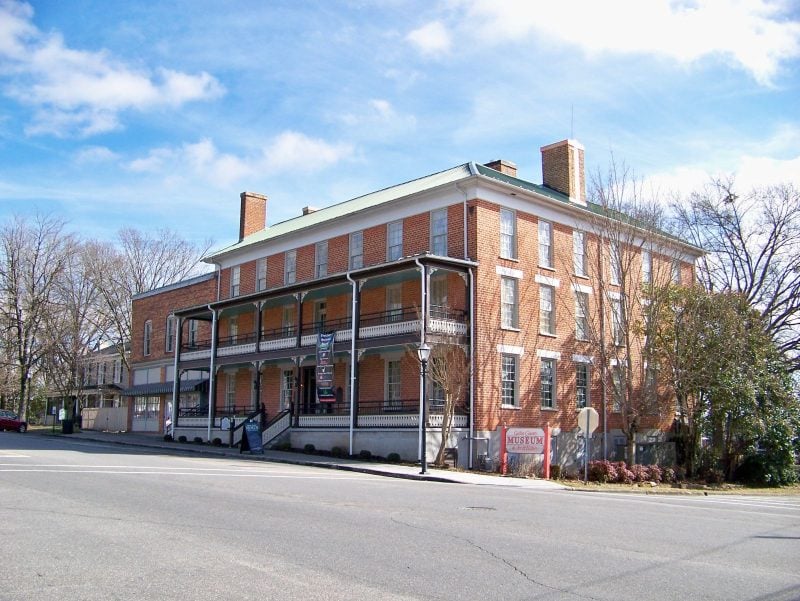
Hoffman is a small rural town in Montgomery County with just over 1,000 residents. The community sits in southern North Carolina and is part of the greater Fayetteville Metropolitan area.
This tight-knit town offers residents peace and quiet that comes with rural living. The area features scenic views and outdoor activity opportunities for nature enthusiasts.
Local businesses provide shopping and dining options for residents. The small size creates a close community atmosphere where neighbors know each other.
Hoffman has received recognition as one of the better places to live in various rankings. The town combines rural charm with proximity to larger metropolitan amenities through its connection to the Fayetteville area.
The location offers an escape from urban density while maintaining access to necessary services and employment opportunities.
29. High Point
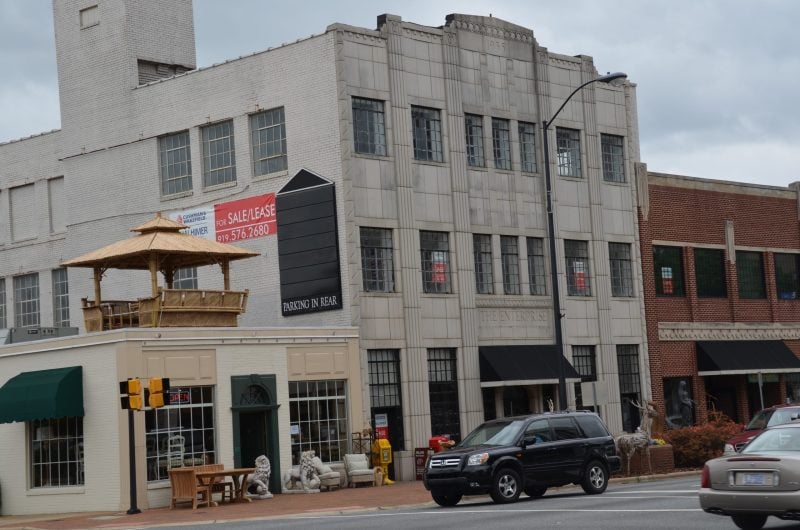
High Point sits in the Piedmont Triad region with a population of 115,263 residents. The city offers a dense suburban atmosphere where most residents own their homes.
Known for its furniture industry, High Point hosts the famous Furniture Market twice yearly. The city combines urban and suburban living options throughout its neighborhoods.
Tree-lined streets and numerous parks create an appealing environment for families. The community maintains a safe atmosphere with access to quality schools.
High Point provides central access to North Carolina’s attractions, from coastal beaches to mountain regions. The city features cultural attractions including museums, art galleries, and live music venues.
Shopping options range from outlet malls to downtown boutiques. Dining establishments offer everything from upscale restaurants to local favorites.
The growing city attracts new residents seeking a balanced lifestyle. High Point’s location in Guilford County provides convenient access to larger metropolitan areas while maintaining its own distinct character.
28. Salisbury
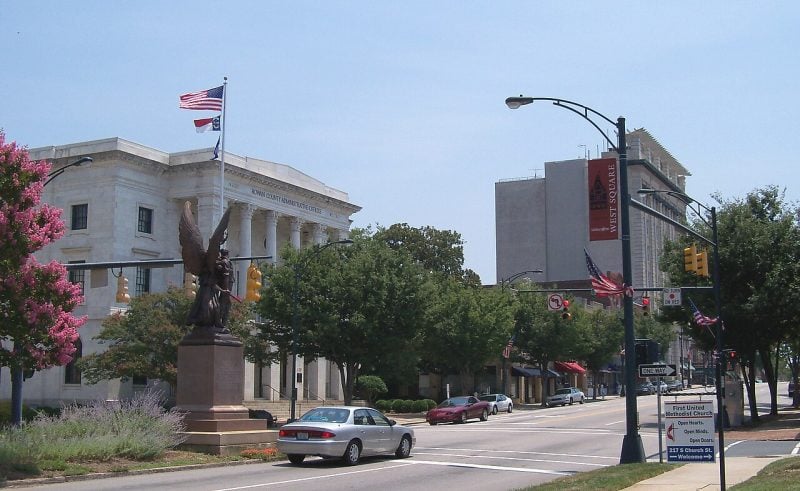
Salisbury sits in Rowan County with a population of approximately 33,663 residents. The city offers a suburban atmosphere with numerous parks and recreational opportunities.
Home prices in Salisbury remain below North Carolina’s state average of $226,477. This affordability makes the area attractive for first-time buyers and families seeking value.
The city receives a livability score of 68 out of 100 according to rankings data. Public schools in the area perform above average compared to state standards.
Salisbury features a diverse community with moderate political views. The rental market provides various housing options for residents at different income levels.
Surrounding areas like Cleveland, Woodleaf, Mount Ulla, and Rockwell offer additional living options. These nearby communities provide alternatives while maintaining access to Salisbury’s amenities and services.
27. Kernersville
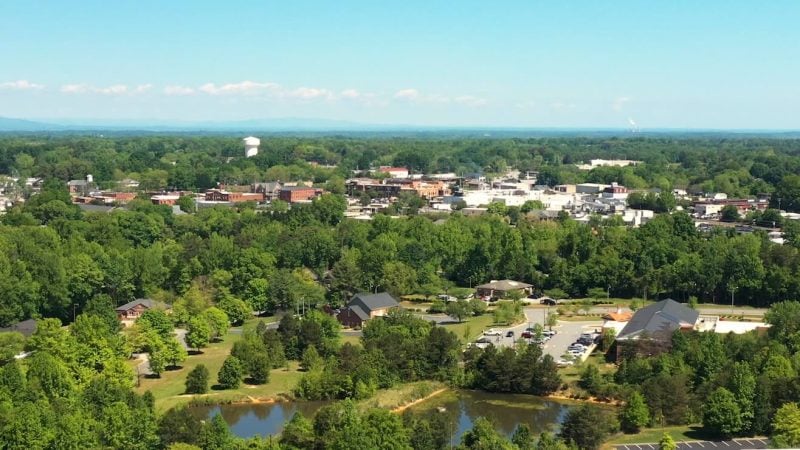
Kernersville is a suburb of Winston-Salem with a population of 27,439 residents. The town sits in Forsyth County within North Carolina’s Piedmont Triad region.
The community offers a dense suburban atmosphere where most residents own their homes. Kernersville provides numerous parks and recreational opportunities for families.
The town features a charming downtown area with historical buildings that reflect its rich heritage. Local restaurants, shopping centers, and entertainment venues serve the community’s needs.
Housing costs in Kernersville remain below North Carolina’s state average of $226,477. This affordability attracts residents seeking value in the real estate market.
The town’s location just outside Winston-Salem provides residents with small-town charm while maintaining access to larger city amenities. Multiple walking trails wind through the area’s beautiful parks.
Kernersville has earned recognition as one of North Carolina’s top places to live according to various ranking organizations.
26. Goldsboro
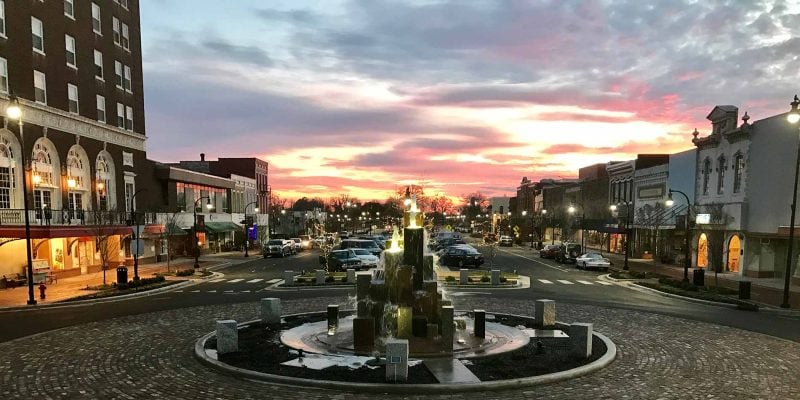
Goldsboro sits in Wayne County with a population of approximately 35,000 residents. The city offers affordable housing options that fall below North Carolina’s state average of $226,477.
The area scores well on quality of life metrics, earning a 77 out of 100 rating. Housing affordability receives particularly high marks with a score of 78 out of 100.
Goldsboro provides access to outdoor activities including hiking and kayaking opportunities. The city hosts local festivals and farmers markets throughout the year.
The median household income is $37,556, which is lower than the national average. The poverty rate stands at 24.3%, notably higher than national figures.
Real estate investors find the area attractive due to steady growth potential and rental demand. The city’s location provides reasonable access to North Carolina’s diverse geographic regions.
25. Fayetteville
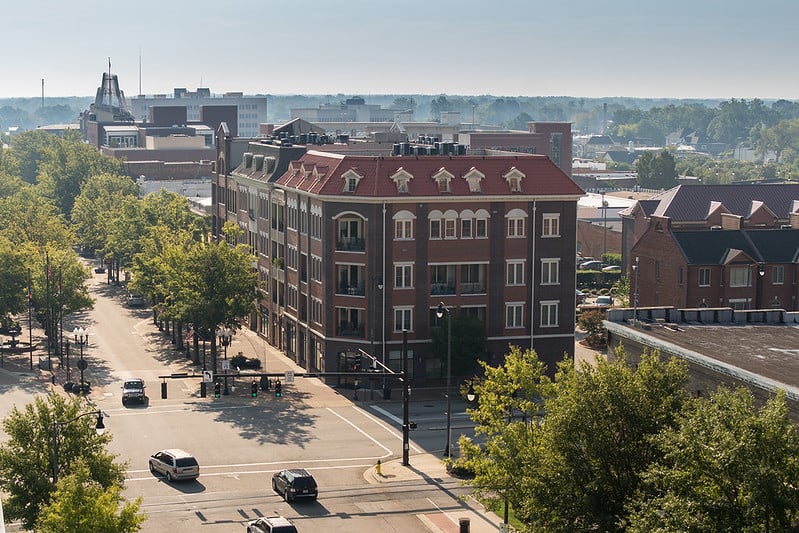
Fayetteville serves as the seat of Cumberland County and home to Fort Liberty, formerly Fort Bragg. The city offers a diverse community with strong military ties and southern hospitality.
The median household income reaches $61,220, making it an affordable option for families. Home prices remain below the state average, with the median property value at $227,407.
History enthusiasts can visit the Airborne and Special Operations Museum and Cool Spring Tavern Museum. The city provides numerous parks and trails for outdoor recreation.
Fayetteville’s location in the Sandhills region offers access to North Carolina’s varied landscapes. Residents enjoy proximity to coastal plains and mountain regions.
The city maintains a vibrant culture with a median age of 32. Multiple neighborhoods provide options for different lifestyles and budgets throughout the area.
24. New Bern
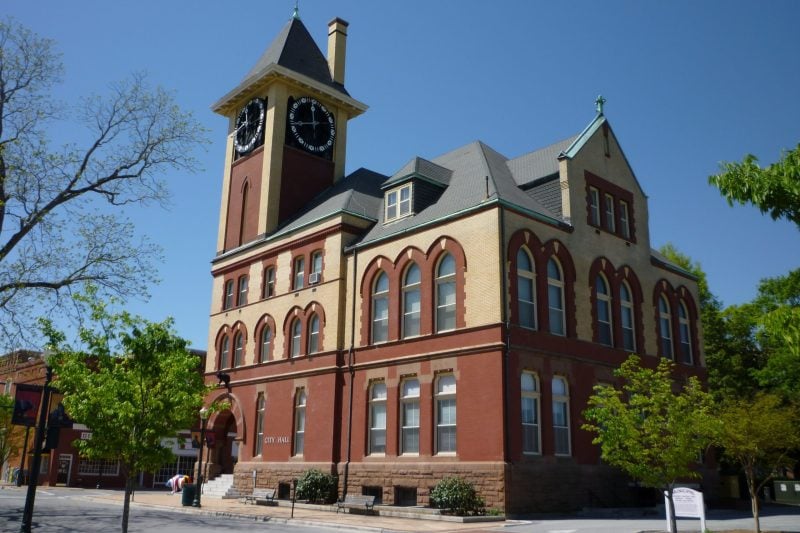
New Bern sits in Craven County along North Carolina’s coastal plain, positioned 110 miles east of Raleigh. The city rests at the confluence of the Neuse and Trent rivers, creating a waterside atmosphere.
With a population of approximately 31,500, New Bern serves families, young professionals, and retirees. The community maintains a dense suburban feel where most residents own their homes.
The city holds historical significance as North Carolina’s first state capital and the birthplace of Pepsi-Cola. Tryon Palace stands as a major tourist attraction showcasing this heritage.
Home prices remain below the state average of $226,477, making the area affordable. The public schools perform above average, attracting families to the region.
Trent Woods ranks among the most desirable neighborhoods, offering proximity to CarolinaEast Medical Center and quality elementary schools. The area provides numerous parks and maintains a moderate political climate.
23. Elizabeth City
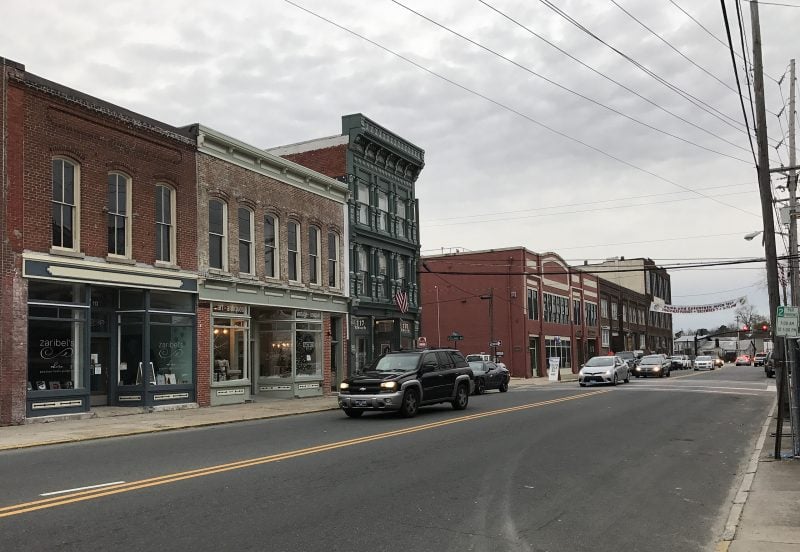
Elizabeth City offers affordable living in northeastern North Carolina with a population of 18,740 residents. The city provides a dense suburban atmosphere where most residents rent their homes.
Home prices in Elizabeth City remain below the state average of $226,477, making it an attractive option for budget-conscious buyers. The lower cost of living compared to other North Carolina cities appeals to families and young professionals.
The city features multiple trails for biking and jogging enthusiasts. The nearby Museum of the Albemarle provides cultural attractions and scenic views for residents.
Elizabeth City serves as the county seat of Pasquotank County and maintains a diverse community. Local shops and restaurants offer unique items and dining experiences throughout the area.
The Elizabeth City-Pasquotank Public Schools system serves families with children. Many young professionals choose this location for its combination of affordability and suburban amenities.
22. Clayton

Clayton stands out as one of Johnston County’s premier locations. The city offers residents a peaceful suburban environment while maintaining close proximity to Raleigh’s urban amenities.
The area attracts families and professionals with its excellent public schools and growing job market. Low crime rates contribute to Clayton’s reputation as a safe community for all ages.
Housing costs remain reasonable compared to nearby metropolitan areas. The median home price aligns closely with North Carolina’s state average of $226,477.
Clayton’s location provides strategic advantages for commuters working in the Research Triangle. Residents enjoy small-town charm without sacrificing access to big-city opportunities and entertainment.
The community has experienced steady population growth as more people discover its balanced lifestyle. Clayton combines affordability with quality amenities, making it an attractive destination for those seeking suburban living near North Carolina’s capital region.
21. Mooresville
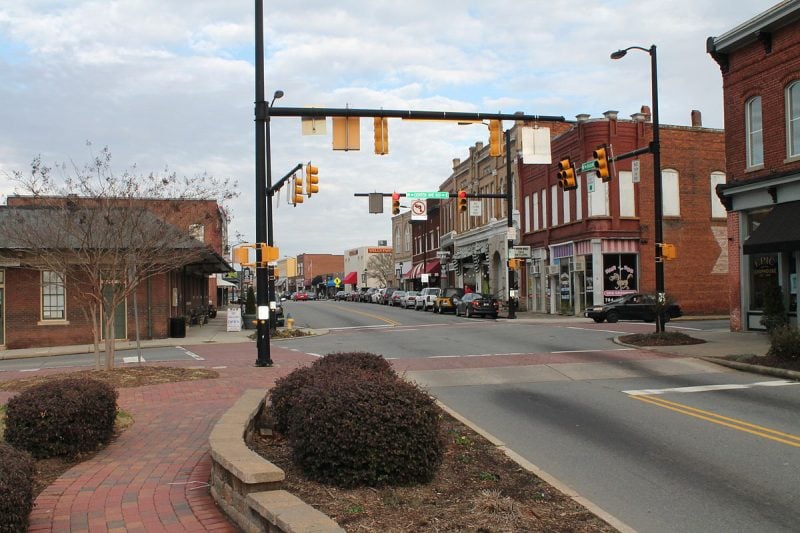
Mooresville stands out as a top-tier destination in North Carolina, earning recognition as the state’s number one place to live according to 2018 research. The city received A+ ratings for public schools, family living, housing, and safety.
Located in Iredell County as a suburb of Charlotte, Mooresville houses 51,447 residents. The community offers a dense suburban atmosphere where most residents own their homes.
Families and young professionals form the core demographic. The city provides diverse cultural attractions including Lazy 5 Ranch and racing venues that reflect the area’s motorsports heritage.
Mooresville sits along the Catawba River in southwest North Carolina. This mid-sized city offers convenient access to both Charlotte amenities and natural landscapes.
The cost of living remains relatively affordable compared to other North Carolina cities. Home prices exceed the state average, reflecting the area’s desirability and strong housing market.
20. Hendersonville

Hendersonville sits in the scenic Blue Ridge Mountains of western North Carolina. The city offers residents mountain views and small-town charm with a population of approximately 14,000.
The area attracts retirees and families seeking a quieter lifestyle. Housing costs are roughly 20-25% lower than major metropolitan areas while remaining above the state average.
Popular neighborhoods include Champion Hills, Kenmure, and Downtown Hendersonville. Mills River and Laurel Park provide additional residential options for newcomers.
Residents benefit from North Carolina’s lack of taxes on Social Security income. The city sits just 23 miles from Asheville, providing access to urban amenities when needed.
Hendersonville has earned recognition as one of the 100 Best Small Towns in America. The community combines mountain recreation with cultural activities and local festivals throughout the year.
19. Davidson
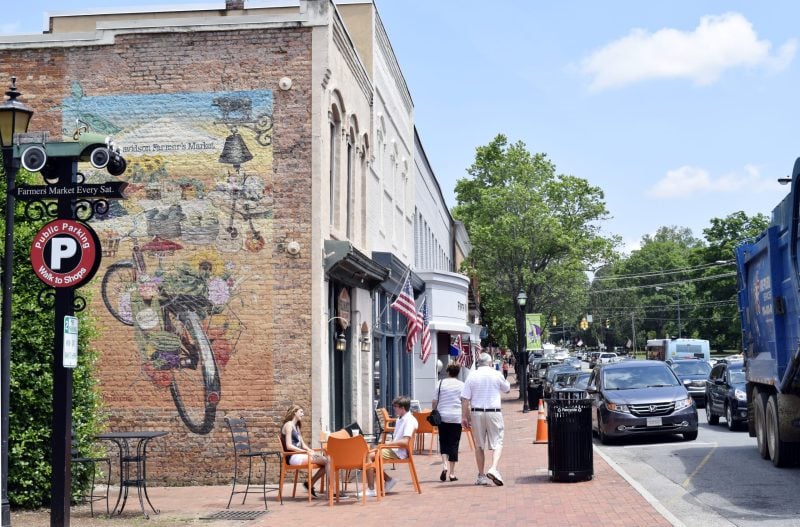
Davidson sits 20 miles north of Charlotte along Lake Norman’s banks. This charming town blends college atmosphere with close-knit community living.
The population reaches 14,852 residents in this Mecklenburg County suburb. Most people own their homes in neighborhoods that command higher prices than the state average.
Davidson earned recognition as one of North Carolina’s best places to live. The town ranked number one on BestPlaces’ list for Mecklenburg County in 2021.
Founded by Presbyterians in 1837, Davidson maintains its historic character while offering modern amenities. Residents enjoy numerous restaurants and parks throughout the area.
The town provides a sparse suburban feel with family-friendly attractions. Davidson College anchors the community with cultural events and concerts.
Fisher Farm Park offers scenic views near the town center. Local shops and eateries contribute to Davidson’s walkable downtown district.
18. Cornelius
Cornelius stands out as one of North Carolina’s premier suburban communities. Located in Mecklenburg County just outside Charlotte, this town offers residents an ideal blend of small-town charm and big-city accessibility.
The community boasts a population of approximately 32,000 residents. Most people own their homes in this dense suburban environment that maintains a welcoming atmosphere.
Home prices reflect the area’s desirability, averaging around $322,400. While this exceeds the state average, residents benefit from lower costs in transportation, utilities, and groceries.
The job market remains robust with thousands of available positions. Charlotte’s proximity provides additional employment opportunities for professionals.
Cornelius offers abundant dining options and recreational facilities. Numerous parks and restaurants serve the community’s diverse needs.
The town consistently ranks among North Carolina’s best places to live. Rankings recognize its livability, safety, and overall quality of life for families and individuals.
17. Carrboro
Carrboro stands out as one of North Carolina’s most desirable communities with a population of 21,170 residents. Located in Orange County near Chapel Hill, this vibrant suburb offers an appealing urban-suburban mix.
The city attracts families seeking excellent educational opportunities and progressive community values. Residents enjoy abundant restaurants and parks throughout the area.
Most people in Carrboro choose to rent their homes rather than buy. The rental market reflects the community’s appeal to young professionals and families.
Home prices in Carrboro exceed North Carolina’s state average of $226,477. This premium reflects strong demand for the area’s amenities and location.
The city provides easy access to the Research Triangle region while maintaining its own distinct character. Carrboro combines small-town charm with metropolitan conveniences.
16. Boone
Boone sits nestled in North Carolina’s Blue Ridge Mountains, offering residents stunning natural scenery and outdoor recreation opportunities. The town serves as home to Appalachian State University, contributing to its vibrant college atmosphere.
With a population of approximately 19,500, Boone maintains a small-town feel while providing urban amenities. The community features numerous restaurants, parks, and cultural attractions that appeal to both students and permanent residents.
The town combines mountain charm with modern conveniences. Residents enjoy access to hiking trails, scenic drives, and year-round outdoor activities in the surrounding Appalachian region.
Boone’s economy benefits from the university presence and tourism industry. The town attracts visitors seeking mountain experiences and outdoor adventures throughout the seasons.
Most residents rent their homes, reflecting the significant student population. The area offers a mix of housing options from apartments to mountain properties.
15. Concord
Concord ranks among the top places to live in North Carolina and earned recognition on Livability’s Top 100 Best Places to Live in the U.S. The city is located northeast of Charlotte, offering residents small-town charm with big-city convenience.
Housing costs remain reasonable, with home prices similar to the state average of $226,477. The city maintains a low unemployment rate and affordable cost of living.
Concord scores well for leisure and culture thanks to Charlotte Motor Speedway and numerous local parks and trails. The city maintains a relatively low crime rate, contributing to its high safety rankings.
Popular neighborhoods include Afton Village, Highland Creek with its golf course, and Christenbury featuring newer homes and quality schools. Historic Downtown provides character with older homes, while Moss Creek offers modern amenities.
The city is one of the fastest-growing in North Carolina, attracting residents with its blend of Southern hospitality and urban accessibility.
14. Matthews
Matthews ranks as the 7th best place to move to in North Carolina. The town earned the top spot in the economy category due to low poverty and unemployment rates.
Located 20 minutes southeast of Charlotte, Matthews offers 29,959 residents a dense suburban atmosphere. Most residents own their homes in this Mecklenburg County community.
The town provides easy access to restaurants, coffee shops, and parks. Home prices exceed the state average of $226,477, reflecting the area’s desirability.
Matthews attracts families and professionals seeking balance between urban convenience and suburban living. The community combines Charlotte’s proximity with a more relaxed residential environment.
Strong home appreciation from 2023 to 2024 demonstrates the area’s economic stability. Low unemployment rates contribute to Matthews’ appeal for working professionals.
13. Huntersville
Huntersville stands as one of North Carolina’s premier suburban communities, located just 15 miles north of Charlotte in Mecklenburg County. The town has earned recognition from Forbes Magazine as the “Best Place to Move” and consistently ranks among the state’s top living destinations.
With a population of approximately 62,000 residents, Huntersville offers a balanced mix of urban convenience and suburban tranquility. The community sits along the scenic shores of Lake Norman, providing residents with abundant recreational opportunities.
The town excels in multiple quality-of-life categories including education, low crime rates, and healthcare access. Home values exceed the state average, reflecting strong market demand and community desirability.
Residents enjoy a sparse suburban atmosphere with extensive parks and green spaces. The area maintains excellent connectivity to Charlotte while preserving its distinct small-town character and rapid growth trajectory.
12. Chapel Hill
Chapel Hill stands out as one of North Carolina’s premier destinations for residents seeking academic excellence and Southern charm. Home to the University of North Carolina, the city creates a vibrant college town atmosphere.
The city recently earned recognition as the 9th best city to live in the United States according to BestPlaces. Chapel Hill also ranked 14th among college towns and 11th for public schools nationwide.
Residents enjoy access to top-tier educational opportunities and cultural amenities. The university brings diverse programming, sports, and intellectual resources to the community.
Chapel Hill’s neighborhoods offer varying price points, though home values exceed the state average of $226,477. The market reflects strong demand from families and professionals drawn to the area’s reputation.
The city combines academic prestige with North Carolina’s traditional hospitality, creating an appealing environment for long-term residents.
11. Morrisville
Morrisville stands out as one of North Carolina’s fastest-growing communities. This Raleigh suburb has earned recognition as the top place to live in the state according to Niche.com.
The town sits in the heart of Research Triangle Park. Residents enjoy easy access to major universities and employment centers within 15 miles of Raleigh, Durham, and Chapel Hill.
Morrisville offers a dense suburban environment with numerous parks and recreational opportunities. The community attracts young professionals, families, and retirees seeking quality amenities.
The town’s location provides proximity to North Carolina State, Duke, and UNC universities. This educational corridor creates a strong economic foundation and cultural vibrancy.
With a population of 30,471, Morrisville maintains its small-town charm while providing modern conveniences. The community features diverse dining options and outdoor attractions that appeal to various lifestyles.
10. Winston-Salem
Winston-Salem combines artistic culture with entrepreneurial innovation in North Carolina’s foothills. The city offers residents a vibrant downtown area and easy access to outdoor recreation.
The West End Historic District features Victorian-era homes in a walkable neighborhood near downtown. Buena Vista provides upscale living with large historic homes and tree-lined streets.
Downtown Winston-Salem attracts young professionals with converted loft spaces and urban amenities. The area maintains a thriving arts scene that contributes to the city’s cultural appeal.
Housing costs remain below the North Carolina state average of $226,477. This affordability makes Winston-Salem accessible to a diverse range of residents.
The city earned recognition as a 2025 Best Place to Live by Livability.com. Rankings considered factors including economy, housing costs, amenities, transportation, and education across nearly 100 data points.
9. Hickory
Hickory stands out as one of North Carolina’s most affordable metropolitan areas. The city earned recognition from U.S. News & World Report, ranking 25th among America’s best places to live for 2023-2024.
Located in Catawba County near the Appalachian Mountain foothills, Hickory offers residents easy access to major urban centers. Charlotte and Asheville are both within driving distance via major highways.
The city maintains a family-friendly atmosphere with downtown farmers markets and welcoming local businesses. Hickory receives positive reviews from residents, earning 3.8 stars from local reviewers.
Housing costs remain below the North Carolina state average of $226,477. This affordability factor contributes to Hickory’s appeal for new residents.
Popular neighborhoods include Downtown Hickory’s revitalized historic area, established Viewmont with quality schools, and scenic Mountain View featuring larger lots and custom homes.
8. Greenville
Greenville stands as the hub of Eastern North Carolina with a population of 88,540 residents. The city combines southern charm with modern amenities that attract families and young professionals.
Most residents rent their homes in this college town atmosphere. The dense suburban feel provides easy access to amenities while maintaining community connections.
Housing costs remain below the North Carolina state average of $226,477. This affordability makes Greenville accessible to various income levels.
The city offers numerous parks and recreational opportunities. East Carolina University contributes to the area’s educational and cultural resources.
Greenville provides ample employment opportunities across multiple sectors. The combination of affordability, amenities, and location has earned recognition on multiple best places to live rankings for 2025.
7. Greensboro
Greensboro ranks as the 7th best place to live in North Carolina, offering an ideal balance of urban convenience and Southern charm. The city has a population of over 306,000 residents.
Housing costs remain below national averages, making Greensboro one of the most affordable large cities in America. The median property value sits at $248,721 with a homeownership rate of 63%.
The city features diverse neighborhoods like Lindley Park, which offers historic and modern homes with strong community connections. New Irving Park provides suburban living with quality schools and newer construction.
Downtown Greensboro attracts young professionals with vibrant nightlife, restaurants, and cultural attractions. The area maintains walkable streets and urban amenities.
Greensboro’s location in central North Carolina provides access to beaches, mountains, and other major cities. The city combines job opportunities with recreational activities and cultural events.
6. Wilmington
Wilmington offers coastal living without breaking the bank. This southern port city combines historic charm with modern amenities along North Carolina’s coast.
The city has grown significantly with over 115,000 residents. Downtown Wilmington features beautiful historic homes alongside vibrant shops and restaurants.
Residents enjoy access to gorgeous beaches and a laid-back coastal lifestyle. The median home price sits around $230,500, making it relatively affordable for coastal living.
Wilmington attracts highly educated professionals who value quality of life. The city maintains a strong connection to the film industry while preserving its historic character.
Popular neighborhoods include the historic downtown area and beachfront communities. Midtown offers family-friendly options with good schools and shopping centers.
The climate receives high marks from residents with comfortable year-round weather. Wilmington provides an attractive balance of cultural amenities, natural beauty, and reasonable cost of living for North Carolina’s coast.
5. Cary
Cary ranks as the #5 best place to live in the United States and #1 in North Carolina according to U.S. News & World Report’s 2025-2026 rankings. This suburb of Raleigh has a population of 176,686 residents in Wake County.
The city offers a dense suburban feel where most residents own their homes. Cary provides numerous restaurants, coffee shops, and parks for daily activities.
Located in the heart of the Research Triangle, Cary sits close to Raleigh, Durham, and Chapel Hill. The city benefits from proximity to high-paying tech sector jobs in Research Triangle Park, ranking in the top 5% for job market strength.
Families appreciate Cary’s low crime rate and top-ranked schools. The community features picturesque neighborhoods and outdoor recreation opportunities, including access to Pine Hollow Park and nearby Umstead State Park.
4. Durham
Durham stands as North Carolina’s fourth most populated city and consistently ranks among the state’s top places to live. The city offers diverse neighborhoods that cater to different lifestyles and preferences.
Downtown Durham attracts young professionals with its vibrant food scene and cultural attractions. Modern lofts and urban amenities make it an appealing choice for city living.
Trinity Park provides a historic neighborhood atmosphere near Duke University. Families and academics gravitate toward this area for its beautiful homes and strong community feel.
The city combines technological advancement with comfortable living spaces. Residents benefit from expansive neighborhoods and regular family events that foster community connections.
Durham’s cost of living remains competitive compared to other major North Carolina cities. The area provides access to quality amenities while maintaining affordability for residents.
3. Raleigh
Raleigh stands as North Carolina’s capital and one of the fastest-growing cities in the United States. The technology industry drives much of this growth, earning the city recognition as a top destination for professionals.
The city offers excellent quality of life with diverse neighborhoods to suit different preferences. North Hills provides a mixed-use environment with shopping, dining, and entertainment integrated into residential areas.
Educational institutions and cultural attractions enhance Raleigh’s appeal. The North Carolina Museum of Art and Pullen Park provide recreational opportunities for residents and visitors alike.
Raleigh’s job market continues expanding, particularly in technology sectors. This growth attracts young professionals and families seeking career opportunities in a thriving metropolitan area.
The cost of living remains reasonable compared to other major cities. Housing options range from urban apartments to suburban neighborhoods, accommodating various budgets and lifestyle preferences throughout the greater Raleigh area.
2. Charlotte
Charlotte stands as North Carolina’s largest city and financial hub. The Queen City combines Southern charm with modern urban sophistication.
The city offers diverse neighborhoods catering to different lifestyles and budgets. From upscale areas to family-friendly suburbs, residents find suitable options throughout the metro area.
Charlotte’s economy centers on banking and finance, with major corporations headquartered downtown. The job market remains strong across multiple industries.
The cost of living stays moderate compared to other major metropolitan areas. Housing prices vary significantly by neighborhood and proximity to the city center.
Cultural attractions include museums, theaters, and a thriving food scene. Professional sports teams and entertainment venues provide year-round activities.
The city’s location provides easy access to both mountains and beaches within a few hours’ drive. Charlotte Douglas International Airport connects residents to destinations worldwide.
1. Asheville
Asheville sits nestled in the Blue Ridge Mountains, offering residents stunning natural scenery and outdoor recreation opportunities. The city has earned recognition as one of the top places to live in North Carolina.
The area attracts residents with its vibrant arts scene and progressive community culture. Local breweries, galleries, and music venues contribute to Asheville’s creative atmosphere.
Several neighborhoods provide different living experiences. Montford features historic Victorian homes along tree-lined streets. West Asheville offers an eclectic mix of restaurants and arts venues.
North Asheville provides family-friendly housing options away from downtown crowds. Biltmore Forest represents the upscale market near the famous Biltmore Estate.
Housing costs exceed North Carolina’s state average, reflecting high demand for the area. The mountains provide hiking, camping, and scenic drives within minutes of residential areas.
Factors That Make a City Desirable
Several key elements determine what makes a North Carolina city an ideal place to call home. Lower crime rates, affordable housing costs, pleasant weather conditions, strong job markets, and quality education systems consistently rank as top priorities for residents.
Cost of Living Considerations
Housing costs represent the largest expense for most families, typically accounting for 25-30% of household income. North Carolina cities offer significant savings compared to coastal states, with median home values ranging from $180,000 in smaller towns to $350,000 in major metropolitan areas.
Key Cost Factors:
Housing (rent/mortgage payments)
Property taxes
Utilities and transportation
Groceries and daily necessities
Cities like Charlotte and Raleigh provide strong job markets but command higher housing prices. Smaller cities such as Greensboro or Winston-Salem offer lower costs while maintaining good amenities.
State income tax rates remain competitive at 4.75% for most earners. Property tax rates vary significantly by county, ranging from 0.57% to 1.2% of assessed value.
Quality of Education
North Carolina’s education system directly impacts family decisions and long-term property values. The state ranks 35th nationally for K-12 education, with significant variation between districts.
Top-Performing School Districts:
Wake County (Raleigh area)
Charlotte-Mecklenburg
Orange County (Chapel Hill)
Higher education options include the University of North Carolina system with 16 campuses. Duke University and Wake Forest University provide additional prestigious options.
Private school enrollment costs average $8,000-$15,000 annually. Charter schools offer alternatives in many communities, particularly in urban areas.
Teacher-to-student ratios and per-pupil spending vary considerably. Affluent suburban districts typically offer more resources and extracurricular programs.
Healthcare Access and Options
Medical care availability and quality significantly affect quality of life, especially for families and retirees. North Carolina ranks 32nd nationally for healthcare access and outcomes.
Major health systems include Duke Health, Atrium Health, and UNC Health. These systems provide comprehensive services in metropolitan areas but coverage becomes limited in rural regions.
Healthcare Metrics:
Primary care physicians per capita
Hospital bed availability
Specialist access
Emergency response times
Cities like Durham, Chapel Hill, and Charlotte offer world-class medical facilities. Rural areas may require travel distances exceeding 45 minutes for specialized care.
Insurance costs and network coverage vary by region. Employer-provided insurance remains the primary coverage source for working-age residents.
Climate and Seasonal Weather
North Carolina’s climate varies from coastal subtropical to mountain temperate zones. The state experiences four distinct seasons with generally mild winters and warm summers.
Average temperatures range from 40°F in January to 80°F in July across most regions. Mountain areas see cooler temperatures and occasional snow, while coastal regions remain warmer year-round.
Weather Considerations:
Hurricane risk (coastal areas)
Humidity levels (60-70% average)
Precipitation (40-50 inches annually)
Growing season length
The Piedmont region offers the most moderate climate conditions. Seasonal allergies from pine pollen affect many residents during spring months.
Weather-related insurance costs increase near the coast due to hurricane exposure.
Economic Opportunities
Employment prospects and wage levels determine long-term financial stability for residents. North Carolina’s economy has diversified beyond traditional manufacturing and agriculture.
Major Industry Sectors:
Technology and research (Research Triangle)
Banking and finance (Charlotte)
Healthcare and biotechnology
Manufacturing and logistics
Unemployment rates typically run 1-2% below national averages. The Research Triangle area leads in high-tech job growth, while Charlotte dominates financial services.
Median household incomes range from $45,000 in rural areas to $75,000+ in metropolitan regions. Cost-adjusted purchasing power often favors North Carolina residents compared to higher-cost states.
Small business formation rates remain strong, supported by university partnerships and state economic development programs.
Lifestyle and Community Offerings
North Carolina cities provide diverse cultural experiences from Asheville’s mountain arts scene to Charlotte’s urban entertainment districts. The state’s geographic diversity creates extensive outdoor recreation opportunities, while major metropolitan areas offer comprehensive public transit and connectivity options.
Arts and Culture Scenes
Charlotte serves as the state’s cultural hub with the Blumenthal Performing Arts Center hosting Broadway shows and the NASCAR Hall of Fame celebrating racing heritage. The NoDa and South End districts feature local galleries, craft breweries, and live music venues.
Asheville offers a thriving arts community centered around the River Arts District. Over 200 artists maintain studios in converted industrial buildings. The city hosts numerous festivals including Bele Chere and maintains strong connections to Appalachian folk traditions.
The Research Triangle area encompasses multiple cultural institutions. Raleigh features the North Carolina Museum of Art and Red Hat Amphitheater. Durham contributes the American Tobacco Historic District with performance spaces and galleries.
Wilmington provides coastal cultural offerings including the Cameron Art Museum and film industry connections. The city’s historic downtown features restored theaters and waterfront festivals.
Outdoor Recreation and Activities
North Carolina’s three geographic regions create diverse recreational opportunities. Mountain communities like Asheville and Boone provide access to hiking trails, skiing at Sugar Mountain, and whitewater rafting on the French Broad River.
Piedmont cities offer state parks, lakes for boating, and extensive greenway systems. Charlotte maintains over 40 miles of greenways connecting neighborhoods to parks and recreational facilities.
Coastal areas including Wilmington and the Outer Banks provide beach access, fishing charters, and water sports. Cape Hatteras National Seashore offers protected beaches and lighthouse climbing.
Golf courses throughout the state include Pinehurst Resort and numerous public courses. The Blue Ridge Parkway provides scenic driving and camping opportunities across western counties.
Transportation and Accessibility
Charlotte operates an extensive light rail system connecting downtown to surrounding suburbs. The LYNX Blue Line serves major employment centers and Charlotte Douglas International Airport.
Research Triangle cities share GoTriangle bus services and bike-share programs. Raleigh-Durham International Airport provides direct flights to major domestic and international destinations.
Interstate highways including I-95, I-85, and I-40 connect major cities. Amtrak service operates through Raleigh, Durham, and Charlotte with connections to Washington DC and Atlanta.
Most mid-sized cities maintain walkable downtown areas with farmers markets and local businesses. Coastal communities often require personal vehicles for accessing beaches and recreational areas outside city centers.




